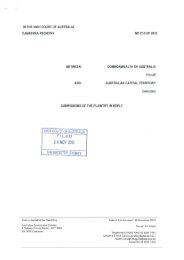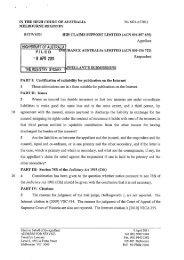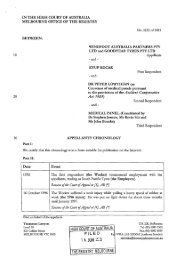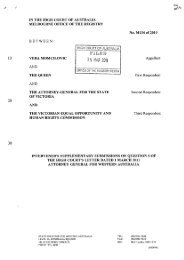HCA Brochure - High Court of Australia
HCA Brochure - High Court of Australia
HCA Brochure - High Court of Australia
Create successful ePaper yourself
Turn your PDF publications into a flip-book with our unique Google optimized e-Paper software.
Decisions <strong>of</strong> the <strong>High</strong> <strong>Court</strong> on appeals are final. There<br />
are no further appeals once a matter has been decided by the<br />
<strong>High</strong> <strong>Court</strong>.<br />
Rules <strong>of</strong> <strong>Court</strong>, which are made by the Justices, set out the<br />
procedural steps that legal practitioners must comply with in<br />
preparing a case for hearing, including the preparation <strong>of</strong> an<br />
appeal book. The appeal book, prepared by the appellant’s<br />
legal practitioner, contains documents necessary for the<br />
<strong>Court</strong> to decide the questions raised in the appeal.<br />
During the hearing the parties present their arguments to<br />
the <strong>Court</strong>, usually through legal representatives.<br />
The <strong>Court</strong> rarely gives its decision (the judgment) at the<br />
end <strong>of</strong> the hearing. Rather, the decision is “reserved” and<br />
presented some time after the hearing. Each Justice makes<br />
his or her own decision on cases, and where decisions are not<br />
unanimous the decision <strong>of</strong> the majority prevails.<br />
The usual practice is for Justices to prepare written reasons<br />
for their decision which are handed down by the <strong>Court</strong> at a<br />
later sitting. Printed copies <strong>of</strong> the judgments are given to the<br />
parties involved immediately after the decision is announced<br />
by the <strong>Court</strong>. Copies <strong>of</strong> judgments are available for sale<br />
to the public from the Registry, or free <strong>of</strong> charge from<br />
the Internet at www.hcourt.gov.au. The decisions are<br />
subsequently recorded in law reports and are now available<br />
on computerised legal databases.<br />
Decisions <strong>of</strong> the <strong>High</strong> <strong>Court</strong> are binding on all other<br />
courts throughout <strong>Australia</strong>.<br />
The <strong>High</strong> <strong>Court</strong> building<br />
The <strong>High</strong> <strong>Court</strong> building located on the shores <strong>of</strong> Lake<br />
Burley Griffin is one <strong>of</strong> Canberra’s major national buildings.<br />
Situated in the parliamentary zone, it is adjacent to the<br />
National Gallery and the National Portrait Gallery and close<br />
to the National Science and Technology Building and the<br />
National Library. The building was opened by Her Majesty<br />
Queen Elizabeth II on 26 May 1980.<br />
The <strong>High</strong> <strong>Court</strong> building is a unique structure. It was<br />
designed by the architectural firm <strong>of</strong> Edwards Madigan<br />
Torzillo & Briggs Pty Ltd, the winners <strong>of</strong> a national<br />
competition.<br />
The 40-metre tall concrete and glass building comprises a<br />
number <strong>of</strong> major functional elements, namely a large public<br />
hall, three courtrooms, an administrative wing, and an area<br />
provided for the Justices.<br />
The forecourt and main entrance <strong>of</strong> the building are<br />
approached via a long ceremonial ramp. A waterfall designed<br />
by Robert Woodward and constructed <strong>of</strong> South <strong>Australia</strong>n<br />
speckled granite runs the full length <strong>of</strong> one side <strong>of</strong> the ramp.<br />
Most <strong>of</strong> the external and internal walls created by the<br />
18,400 cubic metres <strong>of</strong> concrete used in the construction<br />
have been subjected to a process known as “bush<br />
hammering”, carried out with a percussion instrument which<br />
has flaked the surface and exposed the aggregate.<br />
The glazed areas totalling 4,000 square metres use steel<br />
frame supports which means that generous expansion<br />
allowances had to be provided to cope with Canberra’s wide<br />
temperature range. A system was devised so that the glass in<br />
the walls can creep up or down according to the temperature<br />
changes and any movement in the concrete structure.<br />
Public Hall<br />
The public hall is a large area with a 24-metre high ceiling<br />
supported by two large concrete pillars. The tiles on the floor<br />
are cut from Aurisina, an Italian marble, one <strong>of</strong> the very<br />
few imported materials in the building. Access to all three<br />
courtrooms is from the public hall, which is <strong>of</strong>ten used for<br />
cultural exhibitions and public functions.<br />
Located in the public hall are a display case containing<br />
interesting historical items and a theatrette featuring a short<br />
film about the <strong>Court</strong>’s work. The film was presented to the<br />
<strong>Court</strong> by the <strong>Australia</strong>n Bar Association.<br />
Artworks<br />
Several major works <strong>of</strong> art have been included in the<br />
building design. On the northern wall <strong>of</strong> the public hall is a<br />
mural designed by Jan Senbergs to reflect the history, function<br />
and aspirations <strong>of</strong> the <strong>High</strong> <strong>Court</strong>. Attached to what is called<br />
the Constitution Wall, the mural has six different sized panels<br />
linked by a central theme.<br />
Another mural, also by Jan Senbergs, located on the<br />
western or States Wall symbolises the role <strong>of</strong> the states in the<br />
federation and the significance <strong>of</strong> the <strong>High</strong> <strong>Court</strong> as the apex<br />
<strong>of</strong> the judicial system in <strong>Australia</strong>. The mural consists <strong>of</strong> six<br />
double panels, the tops <strong>of</strong> which have stylised state flag<br />
symbols. The lower part <strong>of</strong> the double panel has an abstracted<br />
composition based on various images relating to each state.<br />
Outside <strong>Court</strong>room No.1 there is a wax mural, by Bea<br />
Maddock, describing the events <strong>of</strong> the first sitting <strong>of</strong> the <strong>High</strong><br />
<strong>Court</strong> at the Banco <strong>Court</strong> in Melbourne on 6 October 1903.<br />
On the outside wall <strong>of</strong> <strong>Court</strong>room No. 3 is a painting by<br />
Marcus Beilby depicting the first sitting <strong>of</strong> the <strong>High</strong> <strong>Court</strong> <strong>of</strong><br />
<strong>Australia</strong> in Melbourne in 1903. Opposite is a painting by<br />
Robert Hannaford <strong>of</strong> the <strong>Court</strong> in session in <strong>Court</strong>room 1 in<br />
Canberra 2003.<br />
The <strong>Court</strong>rooms<br />
The building contains three courtrooms <strong>of</strong> different sizes<br />
which are used for different purposes.<br />
No. 1 <strong>Court</strong>room is used on all ceremonial occasions and for<br />
all cases where a Full Bench <strong>of</strong> the seven Justices <strong>of</strong> the <strong>Court</strong><br />
is required to sit. The wall panelling and gallery furniture are<br />
red tulip oak timber from Queensland and New South Wales.<br />
The long curved bench and bar table are made <strong>of</strong> jarrah timber<br />
from Western <strong>Australia</strong>. Aurisina marble has been used on the<br />
floor as well as the face <strong>of</strong> the bench. Blackwood panels have<br />
been used in the ceiling <strong>of</strong> the room.<br />
A woven tapestry in the form <strong>of</strong> a banner incorporates<br />
the badges <strong>of</strong> the states from the Shield <strong>of</strong> Arms <strong>of</strong> the<br />
Commonwealth surmounted by the Crest <strong>of</strong> the<br />
Commonwealth. It was woven in the Victorian Tapestry<br />
Workshop in South Melbourne.<br />
Doors for each <strong>of</strong> the three courtrooms incorporate a special<br />
design, those <strong>of</strong> <strong>Court</strong>room No. 1 featuring a silvered bronze<br />
grid partly recessed and fixed into the laminated plate glass.<br />
The theme <strong>of</strong> the design is a shield, emphasising the <strong>Court</strong>’s<br />
function as a protector <strong>of</strong> the Constitution and the liberties <strong>of</strong><br />
the citizen. The door handles continue the emblematic design.<br />
<strong>Court</strong>room 1<br />
No. 2 <strong>Court</strong>room is generally used in cases where a full<br />
court <strong>of</strong> five Justices is sitting and is also used for hearing<br />
applications for leave to appeal by video-link.<br />
No. 3 <strong>Court</strong>room has been designed for matters dealt with<br />
generally by a single Justice. It has a jury box so that a trial<br />
can be conducted should such a case come before the <strong>Court</strong>.<br />
The courtroom has been furnished with coach wood<br />
timber with a ceiling mainly <strong>of</strong> glass which provides a high<br />
level <strong>of</strong> natural lighting.<br />
<strong>Court</strong>room 3<br />
Portraits <strong>of</strong> the first 11 Chief Justices are displayed in the<br />
three courtrooms.<br />
Photographic portraits <strong>of</strong> all Chief Justices and Justices<br />
who have sat on the <strong>Court</strong> since its inception are displayed<br />
along the wall outside <strong>Court</strong>room No. 1.<br />
Commemorative plaques<br />
A feature wall at the lower entrance to the building<br />
commemorates the present and former Chief Justices and<br />
Justices <strong>of</strong> the <strong>Court</strong>. Each plaque has the name <strong>of</strong> the Justice<br />
and his or her period <strong>of</strong> service. Also adjacent to the lower<br />
entrance is a plaque commemorating the laying <strong>of</strong> the<br />
building’s foundation stone in 1975 by Gough Whitlam,<br />
the then Prime Minister <strong>of</strong> <strong>Australia</strong>.<br />
On the large column as you enter the public hall is<br />
a plaque to commemorate the contribution to the<br />
establishment <strong>of</strong> the <strong>High</strong> <strong>Court</strong> building as the seat <strong>of</strong> the<br />
<strong>High</strong> <strong>Court</strong> <strong>of</strong> <strong>Australia</strong> by the Right Honourable Sir<br />
Garfield Barwick AK GCMG.<br />
Sitting and opening hours<br />
The <strong>High</strong> <strong>Court</strong> building and sittings are open to the<br />
public.<br />
In Canberra, the <strong>Court</strong> usually sits for two weeks each<br />
month other than during law vacations. Normally the <strong>Court</strong><br />
sits Tuesday through Friday in the first week and Tuesday,<br />
Wednesday and Thursday in the second week. Normal sitting<br />
hours are 10.15am to 12.45pm and 2.15pm to 4.15pm.<br />
The building is open from 9:45am to 4:30pm Monday to<br />
Friday (except public holidays), and on Sundays, midday to<br />
4.00pm. The Chambers Cafe on Level One is open 9.45am –<br />
3.00pm Monday – Friday (except public holidays). Lunch is<br />
available 11.30am – 2.00pm.<br />
Information desks are located at the Ground Floor and<br />
Level 2 entrances, and <strong>Court</strong> Guides are on duty throughout<br />
the building to assist you during your visit.<br />
An exhibition area and a video about the role <strong>of</strong> the <strong>Court</strong><br />
are located in the Public Hall.<br />
For visitors with a disability, parking is located under<br />
the portico <strong>of</strong> the building, <strong>of</strong>f Parkes Place,<br />
on the right hand side <strong>of</strong> the building. A wheelchair is<br />
available upon request. Access to the courtrooms is either by<br />
ramps or elevators. Please ask <strong>Court</strong> Guides for assistance.<br />
More information can be found on the <strong>High</strong> <strong>Court</strong><br />
website: www.hcourt.gov.au<br />
HIGH COURT<br />
OF<br />
AUSTRALIA<br />
www.hcourt.gov.au
What is the <strong>High</strong> <strong>Court</strong>?<br />
The <strong>High</strong> <strong>Court</strong> <strong>of</strong> <strong>Australia</strong> is the highest court in the<br />
<strong>Australia</strong>n judicial system. It has its origins in the <strong>Australia</strong>n<br />
Constitution, section 71 <strong>of</strong> which states: “The judicial power<br />
<strong>of</strong> the Commonwealth shall be vested in a Federal Supreme<br />
<strong>Court</strong>, to be called the <strong>High</strong> <strong>Court</strong> <strong>of</strong> <strong>Australia</strong>, and in such<br />
other courts as it invests with federal jurisdiction. The <strong>High</strong><br />
<strong>Court</strong> shall consist <strong>of</strong> a Chief Justice, and so many other<br />
Justices, no less than two, as the Parliament prescribes.”<br />
The functions <strong>of</strong> the <strong>High</strong> <strong>Court</strong> are to interpret and<br />
apply the law <strong>of</strong> <strong>Australia</strong>; to decide cases <strong>of</strong> special federal<br />
significance including challenges to the constitutional<br />
validity <strong>of</strong> laws; and hear appeals, by special leave, from<br />
federal, state and territory courts.<br />
History <strong>of</strong> the <strong>Court</strong><br />
The first sitting <strong>of</strong> the <strong>High</strong> <strong>Court</strong> took place in the Banco<br />
<strong>Court</strong> <strong>of</strong> the Supreme <strong>Court</strong> in Melbourne on 6 October<br />
1903. It was a distinguished bench, comprising three people<br />
who had been prominent in the federation movement:<br />
• Chief Justice Sir Samuel Griffith, former premier<br />
and former Chief Justice <strong>of</strong> Queensland.<br />
• Sir Edmund Barton, the first prime minister and<br />
leader <strong>of</strong> the Constitutional Conventions.<br />
• Richard Edward O’Connor, a former minister for<br />
justice and solicitor-general for New South Wales<br />
and the first leader <strong>of</strong> the government in the Senate.<br />
The <strong>Court</strong> remained comprised <strong>of</strong> three Justices until<br />
1906 when it was increased to five. In 1912 an additional<br />
two Justices were appointed but during 1933, due to the<br />
financial stringencies <strong>of</strong> the Great Depression, the <strong>Court</strong> was<br />
reduced to six Justices when a vacancy was not filled.<br />
The <strong>Court</strong> was restored to its present seven Justices in 1946.<br />
Separate <strong>Court</strong> facilities were provided for the <strong>High</strong> <strong>Court</strong><br />
in Sydney in 1923 and also in Melbourne in 1928. Until<br />
those years the state Supreme <strong>Court</strong> facilities in those cities<br />
were used. The <strong>High</strong> <strong>Court</strong>’s Principal Registry was located<br />
in Melbourne until 1973 then transferred to Sydney.<br />
The <strong>Court</strong> and its Principal Registry transferred to its<br />
permanent home in Canberra in May 1980.<br />
While most sittings are held in Canberra, the <strong>Court</strong> may<br />
sit in the capital cities <strong>of</strong> Queensland, South <strong>Australia</strong>,<br />
Western <strong>Australia</strong> and Tasmania. Also, applications for<br />
special leave to appeal to the <strong>Court</strong> are heard one day<br />
each month in Melbourne and Sydney and on occasions<br />
by video-link with Adelaide, Brisbane, Darwin, Hobart<br />
and Perth.<br />
Chief Justice French AC<br />
Robert Shenton French AC was<br />
appointed Chief Justice <strong>of</strong> the<br />
<strong>High</strong> <strong>Court</strong> <strong>of</strong> <strong>Australia</strong> in<br />
September 2008. At the time <strong>of</strong> his<br />
appointment he was a judge <strong>of</strong> the<br />
Federal <strong>Court</strong> <strong>of</strong> <strong>Australia</strong>, having<br />
been appointed to that <strong>of</strong>fice in<br />
November 1986. He was also an<br />
additional member <strong>of</strong> the Supreme<br />
<strong>Court</strong> <strong>of</strong> the ACT, a member <strong>of</strong> the<br />
Supreme <strong>Court</strong> <strong>of</strong> Fiji, a Deputy<br />
President <strong>of</strong> the <strong>Australia</strong>n Competition Tribunal and a parttime<br />
member <strong>of</strong> the <strong>Australia</strong>n Law Reform Commission.<br />
Chief Justice French graduated from the University <strong>of</strong><br />
Western <strong>Australia</strong> in science and law. He was admitted in<br />
1972 and practised as a barrister and solicitor in Western<br />
<strong>Australia</strong> until 1983 when he went to the Bar. From 1994 to<br />
1998 he was President <strong>of</strong> the National Native Title Tribunal.<br />
From 2001 to 2005 he was president <strong>of</strong> the <strong>Australia</strong>n<br />
Association <strong>of</strong> Constitutional Law. Chief Justice French AC<br />
was appointed a Companion in the General Division <strong>of</strong> the<br />
Order <strong>of</strong> <strong>Australia</strong> in 2010.<br />
Justice Gummow AC<br />
William Montague Charles<br />
Gummow AC was appointed to<br />
the <strong>High</strong> <strong>Court</strong> in April 1995. At<br />
the time he was a judge <strong>of</strong><br />
the Federal <strong>Court</strong> <strong>of</strong> <strong>Australia</strong>. He<br />
graduated from the University <strong>of</strong><br />
Sydney as a Bachelor <strong>of</strong> Arts and<br />
Master <strong>of</strong> Laws. After 10 years in<br />
practice as a solicitor, he was<br />
admitted to the New South Wales<br />
Bar in 1976. He was appointed a<br />
Queen’s Counsel in 1986. For 30 years he lectured part-time<br />
at the University <strong>of</strong> Sydney. Justice Gummow AC was<br />
appointed a Companion in the General Division <strong>of</strong> the<br />
Order <strong>of</strong> <strong>Australia</strong> in 1997.<br />
Justice Hayne AC<br />
Kenneth Madison Hayne AC was<br />
appointed to the <strong>Court</strong> in September<br />
1997. At the time <strong>of</strong> his appointment<br />
he was a judge <strong>of</strong> the <strong>Court</strong> <strong>of</strong> Appeal<br />
<strong>of</strong> Victoria, having been appointed<br />
one <strong>of</strong> the foundation judges <strong>of</strong> that<br />
<strong>Court</strong> in 1995. He graduated in arts<br />
and law from the University <strong>of</strong><br />
Melbourne and as a Bachelor <strong>of</strong> Civil<br />
Law from Oxford University. Elected Rhodes Scholar for Victoria<br />
in 1969, he joined the Victorian Bar in 1971, and was appointed<br />
a Queen’s Counsel in 1984. He practised in state and federal<br />
courts principally in commercial, constitutional and general civil<br />
matters. He was appointed a judge <strong>of</strong> the Supreme <strong>Court</strong> <strong>of</strong><br />
Victoria in 1992. Justice Hayne AC was appointed a Companion<br />
in the General Division <strong>of</strong> the Order <strong>of</strong> <strong>Australia</strong> in 2002.<br />
Justice Heydon AC<br />
(John) Dyson Heydon AC was<br />
appointed to the <strong>Court</strong> in February<br />
2003. At the time <strong>of</strong> his appointment<br />
he was a judge <strong>of</strong> the New South Wales<br />
<strong>Court</strong> <strong>of</strong> Appeal, having been<br />
appointed to that <strong>of</strong>fice in 2000.<br />
He was educated at the University <strong>of</strong><br />
Sydney (BA) and Oxford University<br />
(MA, BCL) as a Rhodes Scholar. He<br />
was admitted to the New South Wales Bar in 1973 and was<br />
appointed a Queen’s Counsel in 1987.<br />
At the age <strong>of</strong> 34 he was elected dean <strong>of</strong> the University <strong>of</strong> Sydney<br />
Law School for the years 1978-1979. He practised at the Bar from<br />
1979 until his appointment to the <strong>Court</strong> <strong>of</strong> Appeal. He has<br />
published a number <strong>of</strong> legal texts including his first book, The<br />
Restraint <strong>of</strong> Trade Doctrine, in 1971. Justice Heydon AC was<br />
appointed a Companion in the General Division <strong>of</strong> the Order <strong>of</strong><br />
<strong>Australia</strong> in 2004.<br />
Justice Crennan AC<br />
Susan Maree Crennan AC was appointed to the <strong>Court</strong> in<br />
November 2005. At the time <strong>of</strong> her appointment she was a judge<br />
<strong>of</strong> the Federal <strong>Court</strong> <strong>of</strong> <strong>Australia</strong>, having been appointed to the<br />
<strong>of</strong>fice in February 2004. She was educated at the University <strong>of</strong><br />
Melbourne (BA and PosgradDipHist) and the University <strong>of</strong><br />
Sydney (LLB). Justice Crennan AC was appointed a Companion<br />
in the General Division <strong>of</strong> the Order <strong>of</strong> <strong>Australia</strong> in 2008.<br />
Justice Kiefel AC<br />
Susan Mary Kiefel AC was appointed<br />
to the <strong>Court</strong> in September 2007. At the<br />
time <strong>of</strong> her appointment she was a judge<br />
<strong>of</strong> the Federal <strong>Court</strong> <strong>of</strong> <strong>Australia</strong> and<br />
the Supreme <strong>Court</strong> <strong>of</strong> Norfolk Island.<br />
She served as a judge <strong>of</strong> the Supreme<br />
<strong>Court</strong> <strong>of</strong> Queensland in 1993-1994<br />
before joining the Federal <strong>Court</strong>. She<br />
was admitted to the Queensland Bar in<br />
1975 and was the first woman in<br />
Queensland to be appointed Queen’s<br />
Counsel, in 1987. Justice Kiefel AC served as a part-time<br />
Commissioner <strong>of</strong> the <strong>Australia</strong>n Law Reform Commission from<br />
2003-2007. She has a Master <strong>of</strong> Laws degree from Cambridge<br />
University. Justice Keifel AC was appointed a Companion in the<br />
General Division <strong>of</strong> the Order <strong>of</strong> <strong>Australia</strong> in 2011.<br />
Justice Bell AC<br />
Justice Crennan AC was admitted to the<br />
NewSouthWalesBarin1979andjoined<br />
the Victorian Bar in 1980. She was<br />
appointed a Queen’s Counsel in 1989.<br />
Justice Crennan AC was president <strong>of</strong> the<br />
<strong>Australia</strong>n Bar Association 1994-95,<br />
Chairman <strong>of</strong> the Victorian Bar Council<br />
in 1993-94, and a Commissioner for<br />
Human Rights in 1992.<br />
Virginia Margaret Bell AC was<br />
appointed to the <strong>Court</strong> in February<br />
2009. At the time <strong>of</strong> her appointment<br />
she was a judge <strong>of</strong> the New South<br />
Wales <strong>Court</strong> <strong>of</strong> Appeal. She graduated<br />
from the University <strong>of</strong> Sydney as a<br />
Bachelor <strong>of</strong> Laws in 1977. After seven<br />
years as a solicitor with the Redfern<br />
Legal Centre, she was admitted to the<br />
New South Wales Bar in 1984 and was<br />
appointed a Senior Counsel in 1997. Justice Bell AC practised as<br />
a public defender between 1986 and 1989 before returning to the<br />
Bar. Between 1994 and 1997 she was a counsel assisting the Royal<br />
Commission into the New South Wales Police Service. Justice<br />
Bell AC was appointed a judge <strong>of</strong> the Supreme <strong>Court</strong> <strong>of</strong> New<br />
South Wales in March 1999. She served as president <strong>of</strong> the<br />
<strong>Australia</strong>n Institute <strong>of</strong> Judicial Administration from 2006 to 2008.<br />
Justices <strong>of</strong> the <strong>Court</strong><br />
There have been 12 Chief Justices <strong>of</strong> the <strong>Court</strong> and 42<br />
Justices since the <strong>Court</strong> was established in 1903.<br />
Chief Justices<br />
Sir Samuel Walker Griffith 1903-1919<br />
Sir Adrian Knox 1919-1930<br />
Sir Isaac Alfred Isaacs 1930-1931<br />
Sir Frank Gavan Duffy 1931-1935<br />
Sir John Greig Latham 1935-1952<br />
Sir Owen Dixon 1952-1964<br />
Sir Garfield Edward John Barwick 1964-1981<br />
Sir Harry Talbot Gibbs 1981-1987<br />
Sir Anthony Frank Mason 1987-1995<br />
Sir (Francis) Gerard Brennan 1995-1998<br />
(Anthony) Murray Gleeson 1998-2008<br />
Robert Shenton French 2008-<br />
Justices <strong>of</strong> the <strong>Court</strong><br />
Sir Edmund Barton 1903-1920<br />
Richard Edward O’Connor 1903-1912<br />
Sir Isaac Alfred Isaacs 1906-1930<br />
Henry Bournes Higgins 1906-1929<br />
Sir Frank Gavan Duffy 1913-1931<br />
Sir Charles Powers 1913-1929<br />
Albert Bathurst Piddington 1913-1913<br />
Sir George Edward Rich 1913-1950<br />
Sir Hayden Erskine Starke 1920-1950<br />
Sir Owen Dixon 1929-1952<br />
Herbert Vere Evatt 1930-1940<br />
Sir Edward Aloysius McTiernan 1930-1976<br />
Sir Dudley Williams 1940-1958<br />
Sir William Flood Webb 1946-1958<br />
Sir Wilfred Kelsham Fullagar 1950-1961<br />
Sir Frank Walters Kitto 1950-1970<br />
Sir Alan Russell Taylor 1952-1969<br />
Sir Douglas Ian Menzies 1958-1974<br />
Sir Victor Windeyer 1958-1972<br />
Sir William Francis Langer Owen 1961-1972<br />
Sir Cyril Ambrose Walsh 1969-1973<br />
Sir Harry Talbot Gibbs 1970-1981<br />
Sir Ninian Martin Stephen 1972-1982<br />
Sir Anthony Frank Mason 1972-1987<br />
Sir Kenneth Sydney Jacobs 1974-1979<br />
Lionel Keith Murphy 1975-1986<br />
Sir Keith Arthur Aickin 1976-1982<br />
Sir Ronald Darling Wilson 1979-1989<br />
Sir (Francis) Gerard Brennan 1981-1995<br />
Sir William Patrick Deane 1982-1995<br />
Sir Daryl Michael Dawson 1982-1997<br />
John Leslie Toohey 1987-1998<br />
Mary Genevieve Gaudron 1987-2003<br />
Michael Hudson McHugh 1989-2005<br />
William Montague Charles Gummow 1995-<br />
Michael Donald Kirby 1996-2009<br />
Kenneth Madison Hayne 1997-<br />
Ian David Francis Callinan 1998-2007<br />
(John) Dyson Heydon 2003-<br />
Susan Maree Crennan 2005-<br />
Susan Mary Kiefel 2007-<br />
Virginia Margaret Bell 2009-<br />
Appointment to the <strong>Court</strong><br />
Justices <strong>of</strong> the <strong>High</strong> <strong>Court</strong> are appointed by the Governor-<br />
General by Commission.<br />
The <strong>High</strong> <strong>Court</strong> <strong>of</strong> <strong>Australia</strong> Act requires the federal<br />
Attorney-General to consult with the attorneys-general <strong>of</strong><br />
the states before an appointment to the <strong>Court</strong> is<br />
recommended.<br />
Until 1977, members <strong>of</strong> the <strong>High</strong> <strong>Court</strong> were appointed<br />
for life. However, following a referendum in 1977, all new<br />
Justices must retire at age 70. There are now no Justices with<br />
life appointments. There have been 12 Chief Justices and 42<br />
Justices since the <strong>Court</strong>’s inauguration. One Justice, Albert<br />
Bathurst Piddington, resigned before taking his place on the<br />
bench. Six Chief Justices were appointed from outside the<br />
<strong>Court</strong> and six appointed from the <strong>High</strong> <strong>Court</strong> Bench.<br />
Operation <strong>of</strong> the <strong>Court</strong><br />
The <strong>High</strong> <strong>Court</strong> <strong>of</strong> <strong>Australia</strong> deals with cases which come<br />
to it on appeal or which begin in the <strong>High</strong> <strong>Court</strong> itself.<br />
Cases which involve interpretation <strong>of</strong> the Constitution,<br />
or where the <strong>Court</strong> may be invited to depart from one <strong>of</strong> its<br />
previous decisions, or where the <strong>Court</strong> considers the<br />
principle <strong>of</strong> law involved to be one <strong>of</strong> major public<br />
importance, are normally determined by a Full Bench<br />
comprising all seven Justices if they are available to sit.<br />
Other cases which come to the <strong>High</strong> <strong>Court</strong> for final<br />
determination involve appeals against the decisions <strong>of</strong> the<br />
Supreme <strong>Court</strong> <strong>of</strong> the states and territories, <strong>of</strong> the Federal<br />
<strong>Court</strong> <strong>of</strong> <strong>Australia</strong> and <strong>of</strong> the Family <strong>Court</strong> <strong>of</strong> <strong>Australia</strong> and<br />
these are usually dealt with by a full court <strong>of</strong> five Justices.<br />
In addition there are certain matters which can be heard<br />
and determined by a single Justice.<br />
The subject matter <strong>of</strong> the cases heard by the <strong>Court</strong><br />
traverses the whole range <strong>of</strong> <strong>Australia</strong>n law, including<br />
contract, company law, copyright, criminal law and<br />
procedure, tax law, insurance, personal injury, property law,<br />
family law, industrial practices and immigration law.<br />
Most <strong>of</strong> the <strong>Court</strong>’s work relates to the hearing <strong>of</strong> appeals<br />
against decisions <strong>of</strong> other courts. There is no automatic right<br />
to have an appeal heard by the <strong>High</strong> <strong>Court</strong> and parties who<br />
wish to appeal must persuade the <strong>Court</strong> in a preliminary<br />
hearing that there are special reasons for the appeal to be<br />
heard.

















